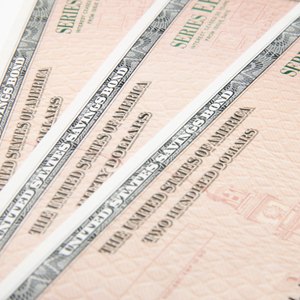
Savings bonds are U.S. Treasury issued savings certificates which grow in value by earning interest. You cannot put savings bonds into a brokerage account for several reasons. However, if you do not want to keep and store your savings bonds in paper form, there is a way to convert your bonds to electronic savings bonds with their own online account.
Savings Bond Ownership
U.S. savings bonds are issued to a named owner. Only a listed owner of a savings bond can make changes to a bond, such as add a co-owner or beneficiary. The major difference for a savings bond, compared to a broker-held security, is that savings bonds can only be redeemed by a listed owner in person. Another party such as a brokerage firm cannot cash in or redeem a savings bond in the owner's name. The owner also cannot transfer the ownership of a bond by signing the bond.
Brokerage Securities
The securities held in a brokerage account are what are referred to as marketable securities. Marketable securities can be bought and sold on the markets where they trade. Stock shares trade on the stock exchanges. Bonds are traded in the secondary markets between bond dealers and brokers. Savings bonds are not marketable securities as they are issued and redeemed, not bought and sold.
Street Name
A brokerage firm holds the stocks or bonds for an investor's account in what is called street name. Shares in a brokerage account are held by the broker in book entry form with the investor listed as the beneficial owner. Holding securities in street name allows the brokerage firm to quickly buy or sell shares when investors place orders to do so. Savings bonds cannot be held in street name. Every savings bond is registered to a specific owner.
Treasury Direct
The option to convert your savings bonds to electronic form is available on the Treasury Direct website. You can open an account on the website and convert your paper savings bonds to electronic form. Your bonds will be listed in your Treasury Direct account. With an online account you can buy and redeem savings bonds using a linked bank account.
References
- SEC: Holding Your Securities -- Get the Facts
- Treasury Direct: Convert Your Paper Savings Bonds Using SmartExchange
- Financial Industry Regulatory Authority. "Bonds and Interest Rates." Accessed Aug. 10, 2020.
- TreasuryDirect. "Interest Rates and Terms for Series EE Savings Bonds." Accessed Aug. 10, 2020.
- U.S. Securities and Exchange Commission. "Bonds." Accessed Aug. 10, 2020.
- Treasury Direct. "Series EE/E Savings Bonds Tax Considerations." Accessed Aug. 10, 2020.
- TreasuryDirect. "Tax Considerations for I Bonds." Accessed Aug. 10, 2020.
- TreasuryDirect. "Education Planning." Accessed Aug. 10, 2020.
- IRS. "Topic No. 403 Interest Received." Accessed Aug. 10, 2020.
- TreasuryDirect. "Series I Savings Bonds FAQs - How Is the Earnings Rate of an I Bond Determined?" Accessed Aug. 10, 2020.
- U.S. Securities and Exchange Commission. "Saving Bonds." Accessed Aug. 10, 2020.
- TreasuryDirect. "Using Your Income Tax Refund to Buy Paper Savings Bonds." Accessed Aug. 10, 2020.
- TreasuryDirect. "Cashing (Redeeming) Series I Savings Bonds." Accessed Aug. 10, 2020.
- TreasuryDirect. "Open an Account - Intro." Accessed Aug. 10, 2020.
- TreasuryDirect. "Convert Your Paper Savings Bonds Using SmartExchange." Accessed Aug. 10, 2020.
- TreasuryDirect. "Savings Bonds as Gifts." Accessed Aug. 10, 2020.
- TreasuryDirect. "Savings Bonds as Gifts." Accessed Aug. 10, 2020.
- TreasuryDirect. "Cashing (Redeeming) EE and E Savings Bonds." Accessed Aug. 10, 2020.
- TreasuryDirect. "When Interest Is Added to Your Bonds." Accessed Aug. 10, 2020.
Writer Bio
Tim Plaehn has been writing financial, investment and trading articles and blogs since 2007. His work has appeared online at Seeking Alpha, Marketwatch.com and various other websites. Plaehn has a bachelor's degree in mathematics from the U.S. Air Force Academy.

